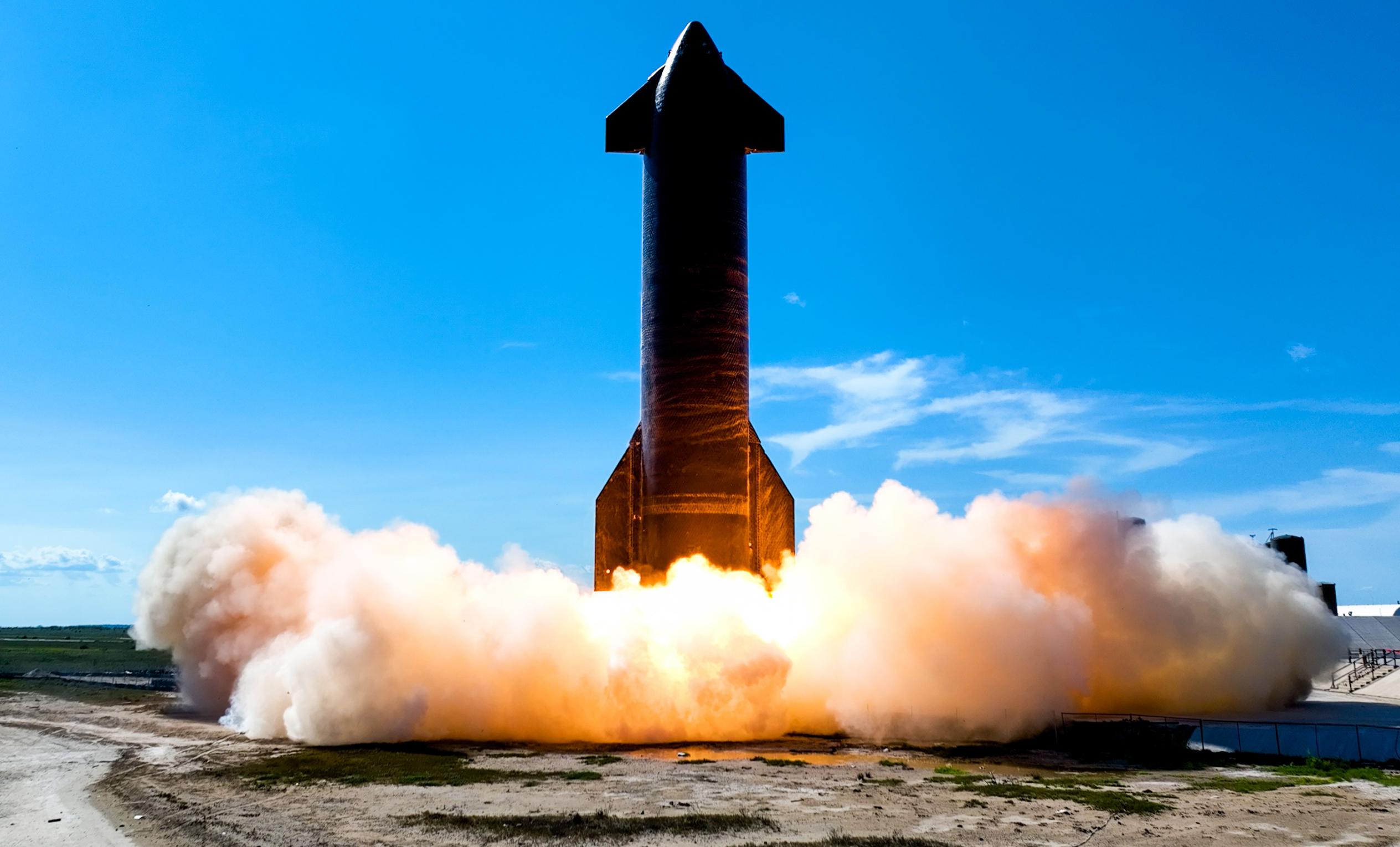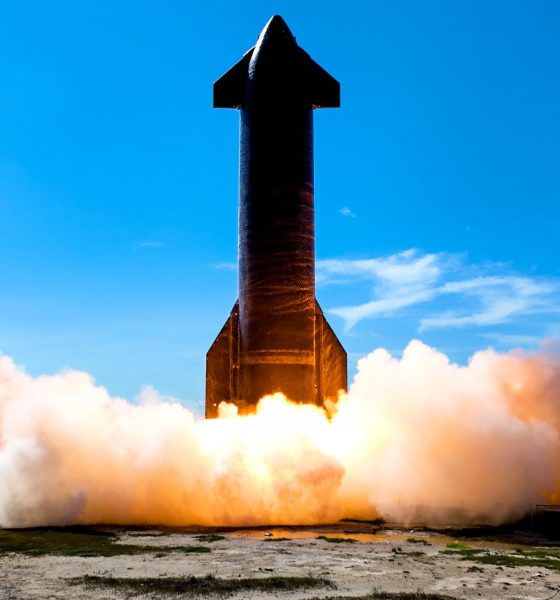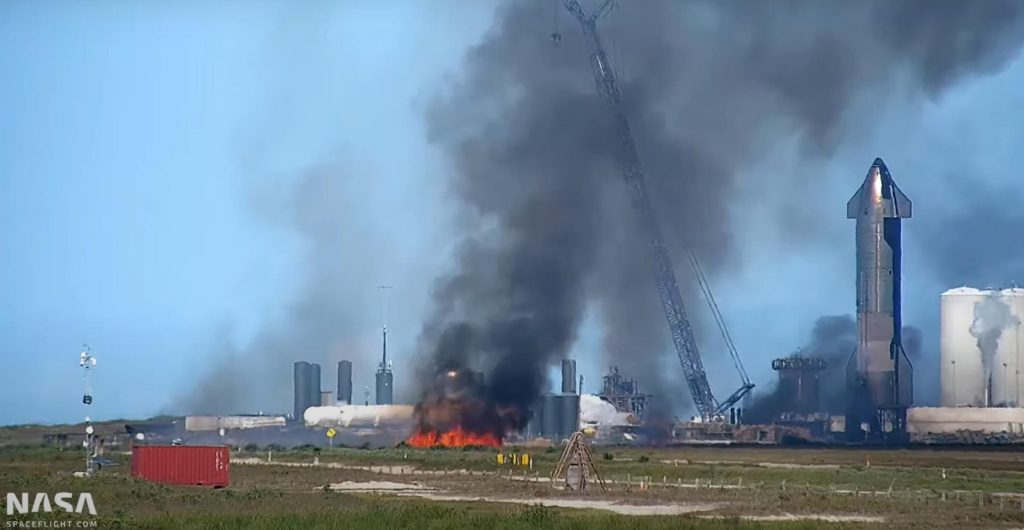

News
SpaceX Starship prototype ignites six engines, starts major brush fire
SpaceX has successfully ignited all six engines on its latest Starship prototype, taking a significant step towards ensuring that the upper stage will be ready for the rocket’s first orbital launch attempt.
Unfortunately, the same successful static fire of a Starship upper stage – potentially producing almost twice as much thrust as the booster of SpaceX’s Falcon 9 rocket – scattered superheated debris hundreds of meters away, igniting a major brush fire. It’s not the first major fire caused by Starship activities in South Texas, and it likely won’t be the last.
Starship S24 completed its first successful static fire on August 9th, igniting two Raptor engines. Several unsuccessful attempts to test more engines followed throughout the rest of the month, and SpaceX ultimately decided to replace one of Starship S24’s three Raptor Vacuum engines in early September before trying again. After workers installed the new engine and buttoned up Ship 24, the stars eventually aligned on September 8th.
Kicking off the test, SpaceX pumped several hundred tons of liquid oxygen (LOx) and a much smaller quantity of liquid methane (LCH4) fuel into Ship 24 in about 90 minutes, producing a crisp layer of frost wherever the cryogenic liquids touched the skin of the rocket’s uninsulated steel tanks. No frost formed on Starship’s upper methane tank, implying that SpaceX only loaded methane fuel into internal ‘header’ tanks meant to store propellant for landings. The hundreds of tons of liquid oxygen, then, were likely meant as ballast, reducing the maximum stress Starship could exert on the test stand holding it to the ground.
That potential stress is substantial. Outfitted with upgraded Raptor 2 engines, Starship S24 could have produced up to 1380 tons (~3M lbf) thrust when it ignited all six for the first time at 4:30 pm CDT. On top of smashing the record for most thrust produced during a Starbase rocket test, Ship 24’s engines burned for almost 8 seconds, making it one of the longest static fires ever performed on a Starship test stand.
Several brush fires were visible almost immediately after clouds of dust and steam cleared. More likely than not, the combination of the extreme force, heat, and burn duration likely obliterated the almost entirely unprotected concrete surface below Ship 24. Despite continuous evidence that all Starship static fire operations would be easier and safer with the systems, SpaceX still refuses to install serious water deluge or flame deflector systems at Starbase’s test stands and launch pads.
Instead, under its steel Starship test stands, SpaceX relies on a single middling deluge spray nozzle and high-temperature concrete (likely martyte) that probably wouldn’t pass muster for a rocket ten times less powerful than Starship. In multiple instances, Starships have shattered that feeble martyte layer, creating high-velocity ceramic shards that damage their undersides or Raptor engines, requiring repairs and creating risky situations. With essentially no attempt at all to tame the high-speed several-thousand-degree Raptor exhaust, static fire tests at Starbase thus almost always start small grass fires and cause minor damage, but those fires rarely spread.

Ship 24’s first six-engine test was not so lucky, although the Starship made it through seemingly unscathed. Most likely, eight long seconds of blast-furnace conditions melted the top layer of surrounding concrete and shot a hailstorm of tiny superheated globules in almost every direction. Indeed, in almost every direction there was something readily able to burn, a fire started. In several locations to the south and west, brush caught fire and began to burn unusually aggressively, quickly growing into walls of flames that sped across the terrain. To the east, debris even made it into a SpaceX dumpster, the contents of which easily caught fire and burned for hours.
Eventually, around 9pm CDT, firefighters were able to approach the safed launch pad and rocket, but the main fire had already spread south, out of reach. Instead, they started controlled burns near SpaceX’s roadblock, hoping to clear brush and prevent the fire (however unlikely) from proceeding towards SpaceX’s Starbase factory and Boca Chica Village homes and residents.
The nature of the estuary-like terrain and wetlands means that it’s very easy to stop fires at choke points, so the fire likely never posed any real threat to Boca Chica residents, SpaceX employees, or onlookers. It was also unlikely to damage SpaceX’s launch facilities or return to damage Starship S24 from the start, as both of are surrounded by a combination of concrete aprons, empty dirt fields, and a highway.
Still, the “brush” burned by the fire is a protected habitat located in a State Park and Wildlife Refuge. While fire is a natural and often necessary element of many habitats, including some of those in Boca Chica, this is the second major brush fire caused by Starship testing since 2019, which may be less than desirable. At a minimum, fighting fires around Starbase generally requires firefighters to walk or even drive on protected wetlands and salt flats, the impact of which could ultimately be as bad for wildlife and habitats as the fire itself.
SpaceX’s Federal Aviation Administration (FAA) Programmatic Environmental Assessment (PEA), which fully greenlit the company’s existing Starbase Texas facilities and launch plans earlier this year, only discusses fire [PDF] a handful of times. Repairing and preventing future damage to wetlands, however, comes up dozens of times and is the subject of numerous conditions SpaceX must meet before the FAA will grant Starship an orbital launch license.
Ultimately, given that the FAA approved that PEA in full awareness of a 2019 brush fire caused by Starhopper (an early Starship prototype) that may have been as bad or worse than 2022’s, there’s a chance that it will play a small role in the ongoing launch licensing process, but the odds of it being a showstopper are close to zero. Still, it would likely benefit SpaceX at least as much as the surrounding Boca Chica wilderness if it can implement changes that prevent major brush fires from becoming a regular ‘accidental’ occurrence.

News
Tesla starts showing how FSD will change lives in Europe
Local officials tested the system on narrow country roads and were impressed by FSD’s smooth, human-like driving, with some calling the service a game-changer for everyday life in areas that are far from urban centers.

Tesla has launched Europe’s first public shuttle service using Full Self-Driving (Supervised) in the rural Eifelkreis Bitburg-Prüm region of Germany, demonstrating how the technology can restore independence and mobility for people who struggle with limited transport options.
Local officials tested the system on narrow country roads and were impressed by FSD’s smooth, human-like driving, with some calling the service a game-changer for everyday life in areas that are far from urban centers.
Officials see real impact on rural residents
Arzfeld Mayor Johannes Kuhl and District Administrator Andreas Kruppert personally tested the Tesla shuttle service. This allowed them to see just how well FSD navigated winding lanes and rural roads confidently. Kruppert said, “Autonomous driving sounds like science fiction to many, but we simply see here that it works totally well in rural regions too.” Kuhl, for his part, also noted that FSD “feels like a very experienced driver.”
The pilot complements the area’s “Citizen Bus” program, which provides on-demand rides for elderly residents who can no longer drive themselves. Tesla Europe shared a video of a demonstration of the service, highlighting how FSD gives people their freedom back, even in places where public transport is not as prevalent.
What the Ministry for Economic Affairs and Transport says
Rhineland-Palatinate’s Minister Daniela Schmitt supported the project, praising the collaboration that made this “first of its kind in Europe” possible. As per the ministry, the rural rollout for the service shows FSD’s potential beyond major cities, and it delivers tangible benefits like grocery runs, doctor visits, and social connections for isolated residents.
“Reliable and flexible mobility is especially vital in rural areas. With the launch of a shuttle service using self-driving vehicles (FSD supervised) by Tesla in the Eifelkreis Bitburg-Prüm, an innovative pilot project is now getting underway that complements local community bus services. It is the first project of its kind in Europe.
“The result is a real gain for rural mobility: greater accessibility, more flexibility and tangible benefits for everyday life. A strong signal for innovation, cooperation and future-oriented mobility beyond urban centers,” the ministry wrote in a LinkedIn post.
News
Tesla China quietly posts Robotaxi-related job listing
Tesla China is currently seeking a Low Voltage Electrical Engineer to work on circuit board design for the company’s autonomous vehicles.

Tesla has posted a new job listing in Shanghai explicitly tied to its Robotaxi program, fueling speculation that the company is preparing to launch its dedicated autonomous ride-hailing service in China.
As noted in the listing, Tesla China is currently seeking a Low Voltage Electrical Engineer to work on circuit board design for the company’s autonomous vehicles.
Robotaxi-specific role
The listing, which was shared on social media platform X by industry watcher @tslaming, suggested that Tesla China is looking to fill the role urgently. The job listing itself specifically mentions that the person hired for the role will be working on the Low Voltage Hardware team, which would design the circuit boards that would serve as the nervous system of the Robotaxi.
Key tasks for the role, as indicated in the job listing, include collaboration with PCB layout, firmware, mechanical, program management, and validation teams, among other responsibilities. The role is based in Shanghai.
China Robotaxi launch
China represents a massive potential market for robotaxis, with its dense urban centers and supportive policies in select cities. Tesla has limited permission to roll out FSD in the country, though despite this, its vehicles have been hailed as among the best in the market when it comes to autonomous features. So far, at least, it appears that China supports Tesla’s FSD and Robotaxi rollout.
This was hinted at in November, when Tesla brought the Cybercab to the 8th China International Import Expo (CIIE) in Shanghai, marking the first time that the autonomous two-seater was brought to the Asia-Pacific region. The vehicle, despite not having a release date in China, received a significant amount of interest among the event’s attendees.
Elon Musk
Elon Musk and Tesla AI Director share insights after empty driver seat Robotaxi rides
The executives’ unoccupied tests hint at the rapid progress of Tesla’s unsupervised Robotaxi efforts.

Tesla CEO Elon Musk and AI Director Ashok Elluswamy celebrated Christmas Eve by sharing personal experiences with Robotaxi vehicles that had no safety monitor or occupant in the driver’s seat. Musk described the system’s “perfect driving” around Austin, while Elluswamy posted video from the back seat, calling it “an amazing experience.”
The executives’ unoccupied tests hint at the rapid progress of Tesla’s unsupervised Robotaxi efforts.
Elon and Ashok’s firsthand Robotaxi insights
Prior to Musk and the Tesla AI Director’s posts, sightings of unmanned Teslas navigating public roads were widely shared on social media. One such vehicle was spotted in Austin, Texas, which Elon Musk acknowleged by stating that “Testing is underway with no occupants in the car.”
Based on his Christmas Eve post, Musk seemed to have tested an unmanned Tesla himself. “A Tesla with no safety monitor in the car and me sitting in the passenger seat took me all around Austin on Sunday with perfect driving,” Musk wrote in his post.
Elluswamy responded with a 2-minute video showing himself in the rear of an unmanned Tesla. The video featured the vehicle’s empty front seats, as well as its smooth handling through real-world traffic. He captioned his video with the words, “It’s an amazing experience!”
Towards Unsupervised operations
During an xAI Hackathon earlier this month, Elon Musk mentioned that Tesla owed be removing Safety Monitors from its Robotaxis in Austin in just three weeks. “Unsupervised is pretty much solved at this point. So there will be Tesla Robotaxis operating in Austin with no one in them. Not even anyone in the passenger seat in about three weeks,” he said. Musk echoed similar estimates at the 2025 Annual Shareholder Meeting and the Q3 2025 earnings call.
Considering the insights that were posted Musk and Elluswamy, it does appear that Tesla is working hard towards operating its Robotaxis with no safety monitors. This is quite impressive considering that the service was launched just earlier this year.








